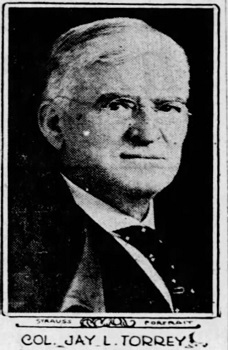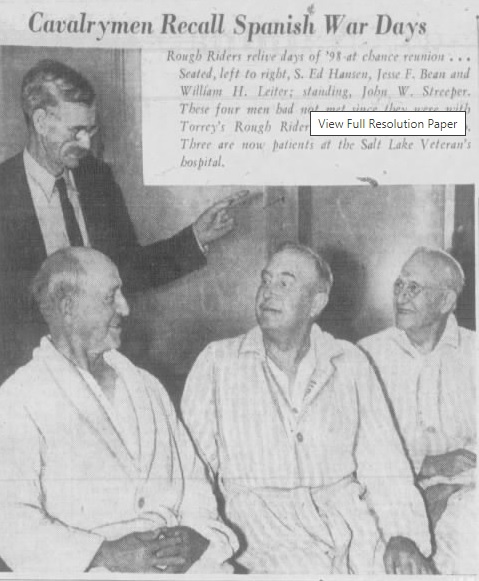

The 2nd U.S. Volunteer Infantry, nicknamed “Torrey’s Rough Riders” served its period of enlistment in the continental U.S. The regiment did not see overseas service..

The History:
The idea of forming a cavalry unit consisting of “cowboys” – men who already lived their lives in the saddle – was mainly the idea of Jay L. Torrey. Though Torrey was the impetus for forming such a regiment, his own regiment was the third of the three such units to be formed. The first two were the 1st U.S. Volunteer Cavalry (“Roosevelt’s Rough Riders”) and the 3rd U.S. Volunteer Cavalry (Grigsby’s Rough Riders”) with the latter completing its mustering in a week prior to Torrey’s regiment, the 2nd U.S. Volunteer Cavalry, or “Torrey’s Rough Riders.” Of these units, only “Roosevelt’s Rough Riders” actually fought in the war, and entered into the forefront of history.
Jay L. Torrey, who became the commanding officer of the 2nd U.S. Volunteer Cavalry was born in Pittsfield, Illinois in 1852. Four years later his father passed away. His mother, Minerva Norton Torrey, became a teacher in Louisiana. Jay Torrey worked at the school to aid his family financially. Eventually Torrey got a law degree. In 1890 Torrey moved to Wyoming to run his brother’s Embar Cattle Company. Later the two brothers also acquired the Owl Creek Cattle Company and the Anchor Cattle Company. In 1894, Jay Torrey was elected to the Wyoming House of Representatives, and was elected Speaker of that body in 1895.
In March of 1898, prior to war being declared, Torrey met with President McKinley and also with Maj. Gen. Nelson Miles to discuss the possibility of a "cowboy regiment." Congress ended up passing a law allowing for the forming of the U.S. Volunteer cavalry regiments.
Torrey’s efforts to raise the regiment bore fruit and the unit was mustered into service at two locations – Denver, Colorado and Cheyenne, Wyoming – between May 1 and May 30, 1898. At the time of mustering in, the regiment consisted of forty-one officers and 968 enlisted men.
The regiment was eventually consolidated at Cheyenne, Wyoming, leaving from this point bound for Jacksonville, Florida on June 25. Unfortunately, whereas “Roosevelt’s Rough Riders” became famous for their actions in Cuba, “Torrey’s Rough Riders” are best known for the tragedy that befell them on this journey. In fact, it was a three-fold tragedy. First, as the trains bearing the regiment were in the rail yards in St. Joseph, Missouri, an accident of some sort occurred. None of the members of the regiment were killed, but two of the train’s crew were killed. The wreckage was cleared and the trains carrying the regiment continued on. While passing through a tunnel, one member of the regiment who may have been riding on the roof, began being suffocated, presumably from the belching smoke in the confined area of the tunnel. The man fell from the car and was killed.
As the trains approached Tupelo, Mississippi, the leading train stopped to refill its water tender, and blew its whistle as a warning to the train that was following. Additionally, a man was sent up the line who frantically tried to warn the approaching second train by waving the flag. The engineer of the second train either did not see the signal or ignored it. The second train rounded a sharp curve and slammed into the rear of the first train at a speed of about thirty miles per hour.
The final cars of the first train were a caboose and the regiment’s
headquarters car. These two cars ended up on top of the engine of the
second train, as a heap of mangled wood and iron. The only occupant was
Col. Torrey, who was thrown from the car, suffering some minor head
injuries and more serious injuries to his feet. The more serious
situation arose as the force of the accident shoved one car through
another in an accident that was commonly called a “telescoping accident”
as one car was shoved through the other like a folded up telescope. The
destruction inside the cars was total.
The car that suffered the most damage was carried Troop C, which was from Laramie, Wyoming. Among the dead were:
---- Gimmer, Troop L
---- Hammer, Troop L, fatally injured
Cornelius Lenihan, Troop C, killed
Will C. Wallace, Troop C, killed
Fourteen additional men were injured, with injuries ranging from bruised legs and a dislocated elbow to legs being completely crushed. As for Col. Torrey, his injuries put him out of action for some time, and Lt. Col. Cannon took over command of the regiment until Torrey was able to return.
The uninjured men were placed aboard other trains and continued toward their destination, arriving at Jacksonville’s Camp Cuba Libre on June 28. At Jacksonville, the regiment was assigned to the Third Division of the Seventh Army Corps. Unfortunately, the regiment was arriving a bit late in the game. The Cuban invasion force had departed two weeks earlier, and the decisive action at Santiago would occur on July 1 with the assault on the San Juan Heights, and followed by the naval battle of Santiago on July 3. The latter resulted in the loss of the entire Spanish naval force in Cuba. The men held out hopes of being sent to Puerto Rico, but that also did not happen.
Life in camp was an endless pattern of drilling and parades in the Florida heat. Still, the men of Torrey’s Rough Riders took their work seriously and gained a an excellent reputation. One visitor, General Burt, said of the regiment that “I saw the drill today, and the movements were executed with a promptness and a precision that astonished me. The evolutions were as perfectly executed as those of any cavalry I have ever seen drill. The horsemanship of the men is superb.” The view was echoed by Gen. Hubbard, who commanded the division of which the regiment was a part. He stated “During my four years of service in the civil war I [saw] many regiments of cavalry, but never one equal to this one.” The regiment was made all the more impressive by careful choice of horses. The horses were roughly all the same size, and the men of each troop were mounted on horses of a single color – either black, chestnut or brown.
In August, the band of the 2nd U.S. Volunteer Cavalry arrived at the regiment’s Jacksonville camp. The band consisted of the well-known touring “Original Dodge City Cowboy Band.” The band was headed by bandmaster Jack Sinclair. The band had offered its services to Col. Torrey when he received the approval to form a regiment. The band was following through on that offer.
Florida presented the men was some unwanted challenges. Many of the men, who were used to the climate of the Rocky Mountains, had difficulty with the heat and humidity of Florida. One of Torrey’s men, Thomas G. Evans of Company F, wrote home that:
“The latter part of June we got our order to prepare to move. The boys showed their approval by giving cheer after cheer, but if they knew at that time that we would have been held in that suffocating hole near Jacksonville, I think a good many of them would have been tempted to desert…Nearly two-thirds of the regiment are disgusted with army life, for what western man who is used to the ranges cares for such strict discipline that is exercised by Uncle Sam?”
Torrey’s Rough Riders were still at Camp Cuba Libre when an armistice was reached with Spain, ending the war’s fighting. The men of the regiment, like many others in the service who had no chance of seeing action, chafed to be mustered out. The 2nd U.S. Volunteer Cavalry was mustered out of service at Jacksonville on October 24, 1898. At the time of mustering out the regiment was considerably smaller than when mustered in, consisting of forty-seven officers and 565 enlisted men.
When the mustering out occurred and the men were paid off and given their travel money, they left Camp Cuba Libre in haste. In fact, they left in such haste that they left tents, field desks, cooking equipment, personal items, wagons, halters and even horses, and mules, in their former camp rather than turn them in. This created great difficulties for the captains of the various troops and the quartermaster of regiment in completing their final property accounts. These men could not be paid off until all property was accounted for. It was not a good ending for the regiment.
During its term of service, the regiment lost sixteen men to disease, had six men killed in accidents, and had four men desert.
The Spanish American War ended on December 10, 1898 with the signing
of the Treaty of Paris.
Colonel Torrey founded the town of Fruitville, Missouri where he had a ten-thousand acre ranch and fruit farm. He ran for the position of U.S. senator from Missouri in 1918, but was defeated. On October 27, 1920, Torrey married Mrs. Frances Reiley, a widow to whom he had been engaged for eleven years. Sadly, Torrey died a few weeks later, on December 4 of the same year. Controversy followed as Torrey had changed his will shortly before his death leaving his entire estate to his new wife and to his personal secretary, cutting out the remainder of his family. The family alleged that the will was not valid, saying Torrey was not in his right mind at the time. The court upheld the new will.

(As a service to our readers, clicking on title in red will take you to that book on Amazon.com)
"Body of Col. Jay L. Torrey to Arrive Here Tomorrow," St. Louis
Post-Dispatch (St. Louis, MO). December 6, 1920, 2 (image of
Torrey)
"Cavalrymen Recall Spanish War Days," The Salt Lake Tribune (Salt
Lake City, UT). September 25, 1939, 9 (image of four vets)
Hoffman, Herald R., “Colonel Jay L. Torrey and his Rough Rider Regiment,” (A these submitted to the Department of History and graduate School of the University of Wyoming) Laramie, WY, 1867, 1-12.
“Col. Jay L. Torrey Dies at 67, Five Weeks After Wedding,” St. Louis Globe-Democrat. December 5, 1920, 1.
“Col. J. L. Torrey Dies Saturday,” The Journal-Gazette (West Plains, MO). December 9, 1920, 1.
“Music for the Rough Riders,” The Kansas City Times (Kansas City, MO). August 8, 1898, 2.
“Near-by News,” The Douglas County Herald (Ava, MO). October 13, 1921, 1.
“Nomination of T.R. for Vice President Barred, Torrey Out,” St. Louis Globe-Democrat. August 2, 1918, 4.
“One of Torrey’s Rough Riders,” The Scranton Tribune (Scranton, PA). September 29, 1898, 10.
“Rail Accident in Mississippi,” Record-Union (Sacramento, CA). June 27, 1898.
“Railroad Rumble,” The Sedalia Democrat (Sedalia, MO). June 27, 1898, 4.
“Scrambled to Quit the Army,” The Galena Evening News (Galena, KS). October 28, 1898, 1.
“Settlement of Torrey Will Case Made in Federal Court,” Springfield Leader and Press (Springfield, MO). October 11, 1922, 4.
Torrey’s July 13 Parade, The Standard Union (Brooklyn, NY). July 13, 1898, 1.
“The Utah Boys in Camp,” The Salt Lake Herald (Salt Lake City, UT). July 8, 1898, 3.